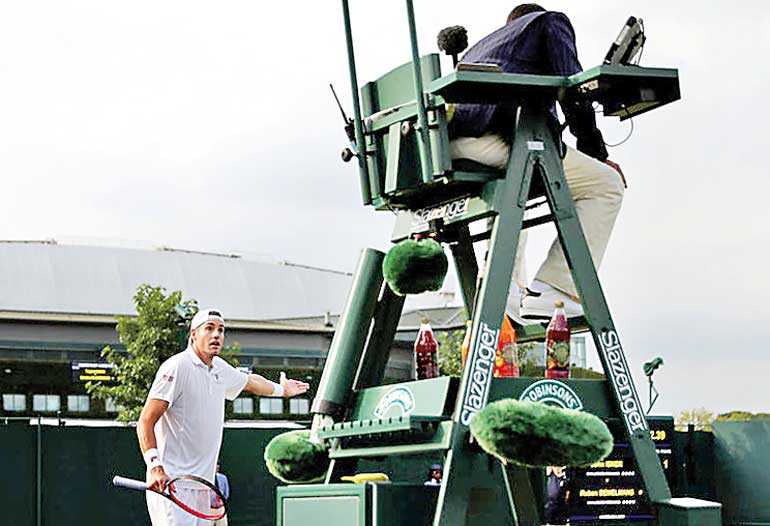Saturday Mar 15, 2025
Saturday Mar 15, 2025
Saturday, 27 October 2018 01:17 - - {{hitsCtrl.values.hits}}

John Isner of the US remonstrates with the umpire after a hawkeye decision review during the second round match against Belgium's Ruben Bemelmans – REUTERS/File Photo
LONDON (Reuters): A Video Review system for judgement calls will be available to umpires and players for the first time at a tennis tournament when this year’s Next Gen ATP Finals starts in Milan next month, the men’s governing body confirmed on Friday.
Using Hawk-Eye technology, the Video Review will give players the chance to challenge judgement calls from the umpire such as whether a ball bounced twice or whether a player inadvertently made an illegal double hit.
It means tennis has followed the example of soccer, NFL and NBA in using Video Review to help reach correct decisions.
While rare, such incidents have caused controversy in tennis, most recently at Wimbledon this year when Novak Djokovic was infuriated after third-round opponent Kyle Edmund was awarded a point despite television replays clearly showing he had failed to scramble up a Djokovic drop shot.
“Adding Video Review will give players a new tool that will further enhance the officiating in our sport,” ATP Executive Chairman and President Chris Kermode said.
Hawk-Eye review technology for line calls has been a long-standing feature of professional tennis. At next month’s tournament, umpires will also be able to review judgement calls on a tablet at their chair, while players will have unlimited access to the new system, even if it is unlikely to be required often throughout the week.
“Controversy with these types of decisions is rare but when they do occur, they can be particularly unsettling for players,” ATP Executive Vice President – Rules and Competition Gayle David Bradshaw said in a statement.
“We do not expect a lot of challenges, but should any instances arise, this technology will ensure the correct decision is reached.”
As well as double bounces and illegal shots, Video Review will also be able to determine ‘touches’ such as whether the ball brushed a player’s racket or body and ‘invasion’, which the ATP describes as when “a player, or anything he is wearing or carrying, touches the opponent’s side of the court while the ball is in play”.
The Next Gen Finals, launched last year to showcase the top eight players aged 21 and under, provides the ATP with a platform to trial new innovations designed to appeal to a new generation of tennis fans.
Human line judges are replaced by computerised calls using Hawk-Eye technology, matches are best of five short sets to four games rather than the traditional six, while games will be decided with a ‘sudden-death’ deuce point.
This year players will also have to retrieve their towels from a rack at the back of the court, rather than having them handed to them by ball kids.
The ATP Next Gen Finals begins at the Milan Fiera on 6 November.
Discover Kapruka, the leading online shopping platform in Sri Lanka, where you can conveniently send Gifts and Flowers to your loved ones for any event including Valentine ’s Day. Explore a wide range of popular Shopping Categories on Kapruka, including Toys, Groceries, Electronics, Birthday Cakes, Fruits, Chocolates, Flower Bouquets, Clothing, Watches, Lingerie, Gift Sets and Jewellery. Also if you’re interested in selling with Kapruka, Partner Central by Kapruka is the best solution to start with. Moreover, through Kapruka Global Shop, you can also enjoy the convenience of purchasing products from renowned platforms like Amazon and eBay and have them delivered to Sri Lanka.
Discover Kapruka, the leading online shopping platform in Sri Lanka, where you can conveniently send Gifts and Flowers to your loved ones for any event including Valentine ’s Day. Explore a wide range of popular Shopping Categories on Kapruka, including Toys, Groceries, Electronics, Birthday Cakes, Fruits, Chocolates, Flower Bouquets, Clothing, Watches, Lingerie, Gift Sets and Jewellery. Also if you’re interested in selling with Kapruka, Partner Central by Kapruka is the best solution to start with. Moreover, through Kapruka Global Shop, you can also enjoy the convenience of purchasing products from renowned platforms like Amazon and eBay and have them delivered to Sri Lanka.